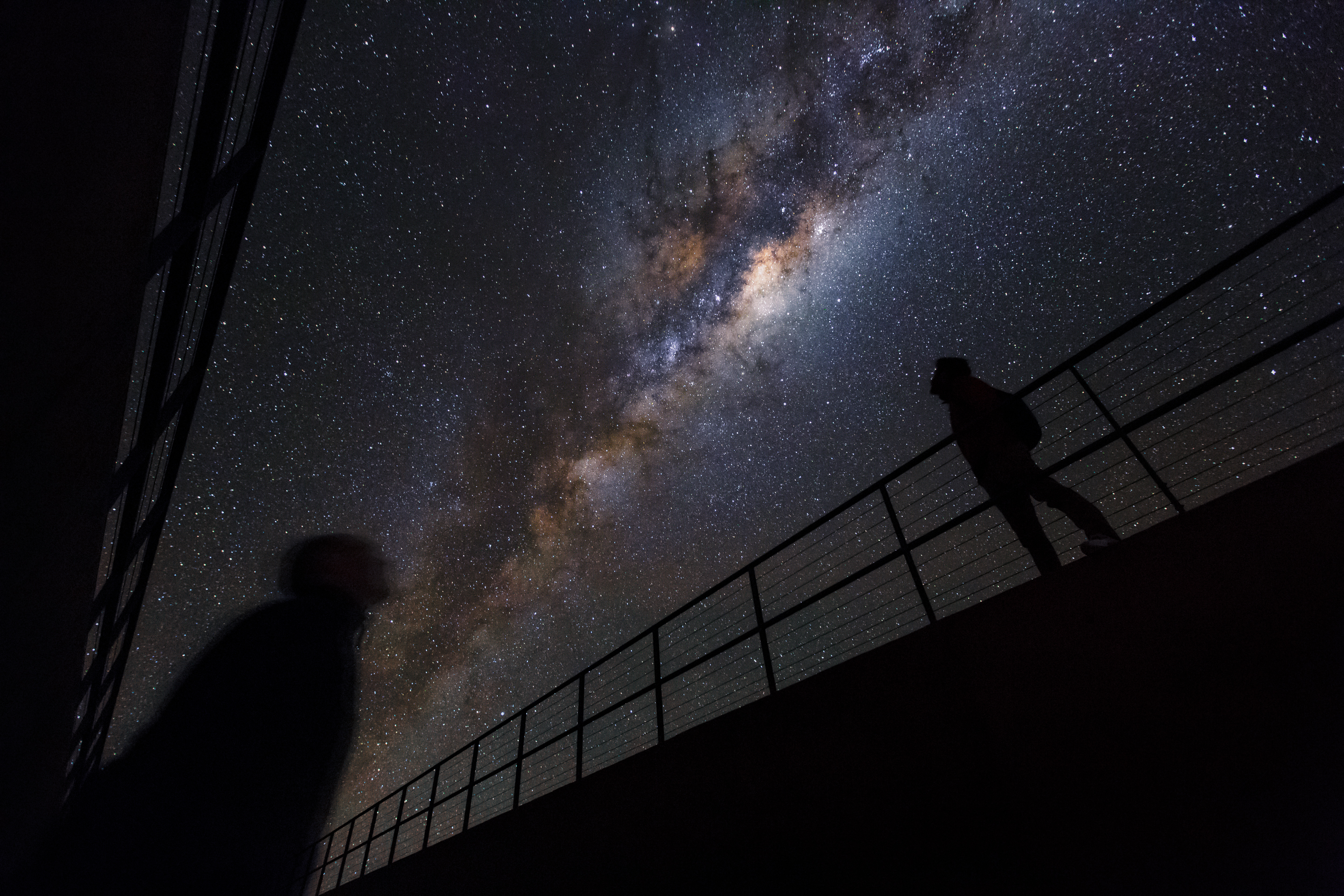|
LRGB
LRGB, short for Luminance, Red, Green and Blue, is a photographic technique used in amateur astronomy for producing good quality color photographs by combining a high-quality black-and-white image with a lower-quality color image.A Simple Guide to the LRGB Technique  In , it is easier and cheaper to obtain good quality, high In , it is easier and cheaper to obtain good quality, high
|
Amateur Astronomy
Amateur astronomy is a hobby where participants enjoy observing or imaging celestial objects in the sky using the Naked eye, unaided eye, binoculars, or telescopes. Even though scientific research may not be their primary goal, some amateur astronomers make contributions in doing citizen science, such as by monitoring variable stars, double stars, sunspots, or occultations of stars by the Moon or asteroids, or by discovering transient astronomical events, such as comets, galactic novae or supernovae in other galaxy, galaxies. Amateur astronomers do not use the field of astronomy as their primary source of income or support, and usually have no professional degree in astrophysics or advanced academic training in the subject. Most amateurs are hobbyists, while others have a high degree of experience in astronomy and may often assist and work alongside professional astronomers. Many astronomers have studied the sky throughout history in an amateur framework; however, since the be ... [...More Info...] [...Related Items...] OR: [Wikipedia] [Google] [Baidu] |
Astrophotography
Astrophotography, also known as astronomical imaging, is the photography or imaging of astronomical objects, celestial events, or areas of the night sky. The first photograph of an astronomical object (the Moon) was taken in 1839, but it was not until the late 19th century that advances in technology allowed for detailed stellar photography. Besides being able to record the details of extended objects such as the Moon, Sun, and planets, modern astrophotography has the ability to image objects outside of the visible spectrum of the human eye such as dim stars, nebulae, and galaxy, galaxies. This is accomplished through long-exposure photography, long time exposure as both film and digital cameras can accumulate and sum photons over long periods of time or using specialized optical filters which limit the photons to a certain wavelength. Photography using extended exposure-times revolutionized the field of professional astronomical research, recording hundreds of thousands of new ... [...More Info...] [...Related Items...] OR: [Wikipedia] [Google] [Baidu] |
Amateur Astronomy
Amateur astronomy is a hobby where participants enjoy observing or imaging celestial objects in the sky using the Naked eye, unaided eye, binoculars, or telescopes. Even though scientific research may not be their primary goal, some amateur astronomers make contributions in doing citizen science, such as by monitoring variable stars, double stars, sunspots, or occultations of stars by the Moon or asteroids, or by discovering transient astronomical events, such as comets, galactic novae or supernovae in other galaxy, galaxies. Amateur astronomers do not use the field of astronomy as their primary source of income or support, and usually have no professional degree in astrophysics or advanced academic training in the subject. Most amateurs are hobbyists, while others have a high degree of experience in astronomy and may often assist and work alongside professional astronomers. Many astronomers have studied the sky throughout history in an amateur framework; however, since the be ... [...More Info...] [...Related Items...] OR: [Wikipedia] [Google] [Baidu] |
Eagle Nebula M16 LRGB Composite
Eagle is the common name for the golden eagle, bald eagle, and other birds of prey in the family of the Accipitridae. Eagles belong to several groups of genera, some of which are closely related. True eagles comprise the genus '' Aquila''. Most of the 68 species of eagles are from Eurasia and Africa. Outside this area, just 14 species can be found—two in North America, nine in Central and South America, and three in Australia. Eagles are not a natural group but denote essentially any kind of bird of prey large enough to hunt sizeable (about 50 cm long or more overall) vertebrates. Etymology The word "eagle" is borrowed into English from and , both derived ultimately from ("eagle"). It is cognate with terms such as , and . It is broadly synonymous with the less common English term "erne" or "earn", deriving from , from , in which it acts as the usual word for the bird. The Old English term is turn derived from and is cognate with other synonymous words in Germanic la ... [...More Info...] [...Related Items...] OR: [Wikipedia] [Google] [Baidu] |
Luminance
Luminance is a photometric measure of the luminous intensity per unit area of light travelling in a given direction. It describes the amount of light that passes through, is emitted from, or is reflected from a particular area, and falls within a given solid angle. The procedure for conversion from spectral radiance to luminance is standardized by the CIE and ISO. Brightness is the term for the ''subjective'' impression of the ''objective'' luminance measurement standard (see for the importance of this contrast). The SI unit for luminance is candela per square metre (cd/m2). A non-SI term for the same unit is the nit. The unit in the Centimetre–gram–second system of units (CGS) (which predated the SI system) is the stilb, which is equal to one candela per square centimetre or 10 kcd/m2. Description Luminance is often used to characterize emission or reflection from flat, diffuse surfaces. Luminance levels indicate how much luminous power could be det ... [...More Info...] [...Related Items...] OR: [Wikipedia] [Google] [Baidu] |
Green
Green is the color between cyan and yellow on the visible spectrum. It is evoked by light which has a dominant wavelength of roughly 495570 nm. In subtractive color systems, used in painting and color printing, it is created by a combination of yellow and cyan; in the RGB color model, used on television and computer screens, it is one of the additive primary colors, along with red and blue, which are mixed in different combinations to create all other colors. By far the largest contributor to green in nature is chlorophyll, the chemical by which plants photosynthesize and convert sunlight into chemical energy. Many creatures have adapted to their green environments by taking on a green hue themselves as camouflage. Several minerals have a green color, including the emerald, which is colored green by its chromium content. During post-classical and early modern Europe, green was the color commonly associated with wealth, merchants, bankers, and the gentry, whil ... [...More Info...] [...Related Items...] OR: [Wikipedia] [Google] [Baidu] |
Blue
Blue is one of the three primary colours in the RYB color model, RYB colour model (traditional colour theory), as well as in the RGB color model, RGB (additive) colour model. It lies between Violet (color), violet and cyan on the optical spectrum, spectrum of visible light. The term ''blue'' generally describes colours perceived by humans observing light with a dominant wavelength that's between approximately 450 and 495 nanometres. Most blues contain a slight mixture of other colours; Azure (color), azure contains some green, while ultramarine contains some violet. The clear daytime sky and the deep sea appear blue because of an optical effect known as Rayleigh scattering#Cause of the blue colour of the sky, Rayleigh scattering. An optical effect called the Tyndall effect explains Eye color#Blue, blue eyes. Distant objects appear more blue because of another optical effect called aerial perspective. Blue has been an important colour in art and decoration since ancient t ... [...More Info...] [...Related Items...] OR: [Wikipedia] [Google] [Baidu] |
Black-and-white Photography
Monochrome photography is photography where each position on an image can record and show a different ''amount'' of light ( value), but not a different color ( hue). The majority of monochrome photographs produced today are black-and-white, either from a gelatin silver process, or as digital photography. Other hues besides grey can be used to create monochrome photography, but brown and sepia tones are the result of older processes like the albumen print, and cyan tones are the product of cyanotype prints. As monochrome photography provides an inherently less accurate reproduction than color photography, it is mostly used for artistic purposes and certain technical imaging applications. Description Although methods for photographing in color emerged slowly starting in the 1850s, monochrome imagery dominated photography until the mid–twentieth century. From the start, photographic recording processes such as the daguerreotype, the paper negative and the glass collodio ... [...More Info...] [...Related Items...] OR: [Wikipedia] [Google] [Baidu] |
Deep View Of The Large And Small Magellanic Clouds
Deep or The Deep may refer to: Places United States * Deep Creek (Appomattox River tributary), Virginia * Deep Creek (Great Salt Lake), Idaho and Utah * Deep Creek (Mahantango Creek tributary), Pennsylvania * Deep Creek (Mojave River tributary), California * Deep Creek (Pine Creek tributary), Pennsylvania * Deep Creek (Soque River tributary), Georgia * Deep Creek (Texas), a tributary of the Colorado River * Deep Creek (Washington), a tributary of the Spokane River * Deep River (Indiana), a tributary of the Little Calumet River * Deep River (Iowa), a minor tributary of the English River * Deep River (North Carolina) * Deep River (Washington), a minor tributary of the Columbia River * Deep Voll Brook, New Jersey, also known as Deep Brook Elsewhere * Deep Creek (Bahamas) * Deep Creek (Melbourne, Victoria), Australia, a tributary of the Maribyrnong River * Deep River (Western Australia) People * Deep (given name) * Deep (rapper), Punjabi rapper from Houston, Texas * Ra ... [...More Info...] [...Related Items...] OR: [Wikipedia] [Google] [Baidu] |
Signal-to-noise Ratio
Signal-to-noise ratio (SNR or S/N) is a measure used in science and engineering that compares the level of a desired signal to the level of background noise. SNR is defined as the ratio of signal power to noise power, often expressed in decibels. A ratio higher than 1:1 (greater than 0 dB) indicates more signal than noise. SNR is an important parameter that affects the performance and quality of systems that process or transmit signals, such as communication systems, audio systems, radar systems, imaging systems, and data acquisition systems. A high SNR means that the signal is clear and easy to detect or interpret, while a low SNR means that the signal is corrupted or obscured by noise and may be difficult to distinguish or recover. SNR can be improved by various methods, such as increasing the signal strength, reducing the noise level, filtering out unwanted noise, or using error correction techniques. SNR also determines the maximum possible amount of data that ... [...More Info...] [...Related Items...] OR: [Wikipedia] [Google] [Baidu] |
Chrominance
Chrominance (''chroma'' or ''C'' for short) is the signal used in video systems to convey the color information of the picture (see YUV color model), separately from the accompanying Luma (video), luma signal (or Y' for short). Chrominance is usually represented as two color-difference components: U = B-Y, B′ − Y′ (blue − luma) and V = R-Y, R′ − Y′ (red − luma). Each of these different components may have scale factors and offsets applied to it, as specified by the applicable video standard. In composite video signals, the U and V signals modulate a color subcarrier signal, and the result is referred to as the chrominance signal; the Phase (waves), phase and amplitude of this modulated chrominance signal correspond approximately to the hue and Saturation (color theory), saturation of the color. In digital-video and still-image color spaces such as Y′CbCr, the luma and chrominance components are digita ... [...More Info...] [...Related Items...] OR: [Wikipedia] [Google] [Baidu] |








